Strategic Analysis of the Renewable Electricity Transition: Power to the World without Carbon Emissions?
Abstract
:1. Introduction
2. Methods
3. Results
4. Discussion
4.1. Environment
4.1.1. Renewable Electricity
4.1.2. Climate Change Impacts
4.1.3. Ecological Overshoot
4.1.4. Critical Minerals
4.1.5. Growing Demand for Electricity Outpaces Renewable Supply
4.1.6. Coal and Fossil Fuels Dominate Electrical Generation
4.1.7. Vulnerability to Extreme Weather
4.2. Political Factors
4.2.1. International Treaties
4.2.2. National Policies
4.2.3. Geopolitics
4.2.4. Green Economy
4.2.5. Industry 4.0
4.3. Legal Frameworks
4.4. Economic
4.4.1. Feasibility
4.4.2. Market
4.4.3. Financing Renewable Energy
4.4.4. Financing Fossil Fuel Subsidies
4.4.5. Investment
4.5. Social
4.5.1. Sustainable Community Energy
4.5.2. Education and Training to Build and Operate RETs
4.5.3. Social Acceptance of Renewables
4.5.4. Social Injustices
4.5.5. Energy Security
4.6. Technology
4.6.1. Decentralized or Distributed Technology
4.6.2. The Smart Electric Grid
4.6.3. Energy System Stability
4.6.4. Rapid Technological Transition
4.6.5. Heat for Manufacturing
4.6.6. Critical Minerals and Batteries
5. Conclusions
Funding
Data Availability Statement
Conflicts of Interest
References
- IPCC. AR6 Synthesis Report: Climate Change 2023; IPCC: Geneva Switzerland, 2023; Available online: https://report.ipcc.ch/ar6syr/pdf/IPCC_AR6_SYR_SPM.pdf (accessed on 3 January 2023).
- USEPA. Using a Total Environment Framework (Built, Natural, Social Environments) to Assess Life-long Health Effects of Chemical Exposures Request for Applications (RFA); U.S. Environmental Protection Agency: Washington, DC, USA. Available online: https://www.epa.gov/research-grants/using-total-environment-framework-built-natural-social-environments-assess-life (accessed on 13 April 2023).
- IEA. World Energy Outlook 2022; IEA: Paris, France, 2022; Available online: https://iea.blob.core.windows.net/assets/830fe099-5530-48f2-a7c1-11f35d510983/WorldEnergyOutlook2022.pdf (accessed on 3 January 2023).
- IEA. Electricity Market Report; IEA: Paris, France, 2023. [Google Scholar] [CrossRef]
- IEA. The World’s Electricity Systems Must Be Ready to Counter the Growing Climate Threat; IEA: Paris, France, 2021; Available online: https://www.iea.org/commentaries/the-world-s-electricity-systems-must-be-ready-to-counter-the-growing-climate-threat (accessed on 14 April 2023).
- IPCC. Climate Change 2022: Mitigation of Climate Change; IPCC: Geneva Switzerland, 2022; Available online: https://www.ipcc.ch/report/ar6/wg3/downloads/report/IPCC_AR6_WGIII_FullReport.pdf (accessed on 3 January 2023).
- UN/UNFCCC. Paris Agreement. 2015. Available online: https://unfccc.int/sites/default/files/english_paris_agreement.pdf (accessed on 3 January 2023).
- IEA. Global CO2 Emissions Rebounded to Their Highest Level in History in 2021; IEA: Paris, France, 2021; Available online: https://www.iea.org/news/global-co2-emissions-rebounded-to-their-highest-level-in-history-in-2021 (accessed on 14 April 2023).
- Matuszewska-Janica, A.; Żebrowska-Suchodolska, D.; Ala-Karvia, U.; Hozer-Koćmiel, M. Changes in Electricity Production from Renewable Energy Sources in the European Union Countries in 2005–2019. Energies 2021, 14, 6276. [Google Scholar] [CrossRef]
- Wang, W.H.; Moreno-Casas, V.; Huerta De Soto, J.; Peña-Ramos, A.; Aldieri, L.; Schaeffer, P.V. A Free-Market Environmentalist Transition toward Renewable Energy: The Cases of Germany, Denmark, and the United Kingdom. Energies 2021, 14, 4659. [Google Scholar] [CrossRef]
- Potrč, S.; Čuček, L.; Martin, M.; Kravanja, Z. Sustainable Renewable Energy Supply Networks Optimization—The Gradual Transition to a Renewable Energy System within the European Union by 2050. Renew. Sustain. Energy Rev. 2021, 146, 111186. [Google Scholar] [CrossRef]
- Bogdanov, D.; Ram, M.; Aghahosseini, A.; Gulagi, A.; Oyewo, A.S.; Child, M.; Caldera, U.; Sadovskaia, K.; Farfan, J.; De Souza Noel Simas Barbosa, L.; et al. Low-Cost Renewable Electricity as the Key Driver of the Global Energy Transition towards Sustainability. Energy 2021, 227, 120467. [Google Scholar] [CrossRef]
- Maruf, M.N.I. Open Model-Based Analysis of a 100% Renewable and Sector-Coupled Energy System–The Case of Germany in 2050. Appl. Energy 2021, 288, 116618. [Google Scholar] [CrossRef]
- Pietzcker, R.C.; Osorio, S.; Rodrigues, R. Tightening EU ETS Targets in Line with the European Green Deal: Impacts on the Decarbonization of the EU Power Sector. Appl. Energy 2021, 293, 116914. [Google Scholar] [CrossRef]
- Chaturvedi, V.; Malyan, A. Implications of a Net-Zero Target for India’s Sectoral Energy Transitions and Climate Policy. Oxford Open Clim. Chang. 2022, 2, kgac001. [Google Scholar] [CrossRef]
- Das, P.; Mathuria, P.; Bhakar, R.; Mathur, J.; Kanudia, A.; Singh, A. Flexibility Requirement for Large-Scale Renewable Energy Integration in Indian Power System: Technology, Policy and Modeling Options. Energy Strategy Rev. 2020, 29, 100482. [Google Scholar] [CrossRef]
- Bhattarai, U.; Maraseni, T.; Apan, A. Assay of Renewable Energy Transition: A Systematic Literature Review. Sci. Total Environ. 2022, 833, 155159. [Google Scholar] [CrossRef]
- IRENA. Renewable Energy Statistics 2022; IRENA International Renewable Energy Agency: Abu Dhabi, United Arab Emirates, 2022; Available online: https://www.irena.org/-/media/Files/IRENA/Agency/Publication/2022/Jul/IRENA_Renewable_energy_statistics_2022.pdf?rev=8e3c22a36f964fa2ad8a50e0b4437870 (accessed on 15 April 2023).
- Yuan, X.; Su, C.W.; Umar, M.; Shao, X.; LobonŢ, O.R. The Race to Zero Emissions: Can Renewable Energy Be the Path to Carbon Neutrality? J. Environ. Manag. 2022, 308, 114648. [Google Scholar] [CrossRef]
- Thompson, H. The Geopolitics of Fossil Fuels and Renewables Reshape the World. Nature 2022, 603, 364. [Google Scholar] [CrossRef] [PubMed]
- Attride-Stirling, J. Thematic Networks: An Analytic Tool for Qualitative Research. Qual. Res. 2001, 1, 385–405. [Google Scholar] [CrossRef]
- Huhta, K. The Contribution of Energy Law to the Energy Transition and Energy Research. Glob. Environ. Change 2022, 73, 102454. [Google Scholar] [CrossRef]
- Plant, G. Offshore Renewable Energy: Smooth Permitting, Environmental Assessment and Fair Use Allocation. Res. Gate 2023, 14, 73–95. [Google Scholar]
- Meyer, N.I. Development of Danish Wind Power Market. Energy Environ. 2004, 15, 657–673. [Google Scholar] [CrossRef]
- Enerdata.net. Consumption of Coal and Lignite. Available online: https://yearbook.enerdata.net/coal-lignite/coal-world-consumption-data.html (accessed on 14 April 2023).
- World Economic Forum in Collaboration with Accenture. Shaping the Future of Energy and Materials System Value Framework and Analysis Summary. 2020. Available online: https://www3.weforum.org/docs/WEF_Overview_Path_to_Maximise_System_Value_2020.pdf (accessed on 17 April 2023).
- Hanni, M.S.; Van Giffen, T.; Krüger, R.; Mirza, H. Foreign Direct Investment in Renewable Energy: Trends, Drivers and Determinants. Transnatl. Corp. 2011, 20, 29–65. [Google Scholar] [CrossRef]
- Pablo-Romero, M.P.; Sánchez-Braza, A.; Galyan, A. Renewable Energy Use for Electricity Generation in Transition Economies: Evolution, Targets and Promotion Policies. Renew. Sustain. Energy Rev. 2021, 138, 110481. [Google Scholar] [CrossRef]
- Tükenmez, M.; Demireli, E. Renewable Energy Policy in Turkey with the New Legal Regulations. Renew. Energy 2012, 39, 1–9. [Google Scholar] [CrossRef]
- Davies, M.; Swilling, M.; Wlokas, H.L. Towards New Configurations of Urban Energy Governance in South Africa’s Renewable Energy Procurement Programme. Energy Res. Soc. Sci. 2018, 36, 61–69. [Google Scholar] [CrossRef]
- Ackah, I.; Graham, E. Meeting the Targets of the Paris Agreement: An Analysis of Renewable Energy (RE) Governance Systems in West Africa (WA). Clean Technol. Environ. Policy 2021, 23, 501–507. [Google Scholar] [CrossRef]
- Arens, M.; Åhman, M.; Vogl, V. Which Countries Are Prepared to Green Their Coal-Based Steel Industry with Electricity?—Reviewing Climate and Energy Policy as well as the Implementation of Renewable Electricity. Renew. Sustain. Energy Rev. 2021, 143, 110938. [Google Scholar] [CrossRef]
- Sawhney, A. Striving towards a Circular Economy: Climate Policy and Renewable Energy in India. Clean Technol. Environ. Policy 2021, 23, 491–499. [Google Scholar] [CrossRef]
- Kuamoah, C. Renewable Energy Deployment in Ghana: The Hype, Hope and Reality. Insight Afr. 2020, 12, 45–64. [Google Scholar] [CrossRef]
- Lindberg, M.B.; Claes, D.H.; Szulecki, K. The EU Emissions Trading System and Renewable Energy Policies: Friends or Foes in the European Policy Mix? Polit. Gov. 2019, 7, 105–123. [Google Scholar] [CrossRef]
- Rana, A.; Gróf, G. Assessment of the Electricity System Transition towards High Share of Renewable Energy Sources in South Asian Countries. Energies 2022, 15, 1139. [Google Scholar] [CrossRef]
- Zhang, H.; Zhao, X.; Zhang, R. Synergistic Development of Heating System Decarbonization Transition and Large-Scale Renewable Energy Penetration: A Case Study of Beijing. Energy Convers. Manag. 2022, 269, 116142. [Google Scholar] [CrossRef]
- Peyerl, D.; Barbosa, M.O.; Ciotta, M.; Pelissari, M.R.; Moretto, E.M. Linkages between the Promotion of Renewable Energy Policies and Low-Carbon Transition Trends in South America’s Electricity Sector. Energies 2022, 15, 4293. [Google Scholar] [CrossRef]
- McCarthy, B.; Eagle, L.; Lesbirel, H. Barriers to the Diffusion of Renewable Energy in Queensland. Rural Soc. 2017, 26, 210–224. [Google Scholar] [CrossRef]
- Xu, Y.; Sharma, T. Explaining Expedited Energy Transition toward Renewables by COVID-19 in India. Energy Policy 2022, 165, 112986. [Google Scholar] [CrossRef]
- Hong, L.; Zhou, N.; Fridley, D.; Raczkowski, C. Assessment of China’s Renewable Energy Contribution during the 12th Five Year Plan. Energy Policy 2013, 62, 1533–1543. [Google Scholar] [CrossRef]
- Cho, S.; Kim, H.; Lee, S.; Kim, S.; Jeon, E.C. Optimal Energy Mix for Greenhouse Gas Reduction with Renewable Energy—The Case of the South Korean Electricity Sector. Energy Environ. 2020, 31, 1055–1076. [Google Scholar] [CrossRef]
- Gallo Cassarino, T.; Barrett, M. Meeting UK Heat Demands in Zero Emission Renewable Energy Systems Using Storage and Interconnectors. Appl. Energy 2022, 306, 118051. [Google Scholar] [CrossRef]
- Goers, S.; Rumohr, F.; Fendt, S.; Gosselin, L.; Jannuzzi, G.M.; Gomes, R.D.M.; Sousa, S.M.S.; Wolvers, R. The Role of Renewable Energy in Regional Energy Transitions: An Aggregate Qualitative Analysis for the Partner Regions Bavaria, Georgia, Québec, São Paulo, Shandong, Upper Austria, and Western Cape. Sustainability 2021, 13, 76. [Google Scholar] [CrossRef]
- Mojumder, M.R.H.; Hasanuzzaman, M.; Cuce, E. Prospects and Challenges of Renewable Energy-Based Microgrid System in Bangladesh: A Comprehensive Review. Clean Technol. Environ. Policy 2022, 24, 1987–2009. [Google Scholar] [CrossRef]
- Alharbi, F.R.; Csala, D. GCC Countries’ Renewable Energy Penetration and the Progress of Their Energy Sector Projects. IEEE Access 2020, 8, 211986–212002. [Google Scholar] [CrossRef]
- Rodríguez-Segura, F.J.; Osorio-Aravena, J.C.; Frolova, M.; Terrados-Cepeda, J.; Muñoz-Cerón, E. Social Acceptance of Renewable Energy Development in Southern Spain: Exploring Tendencies, Locations, Criteria and Situations. Energy Policy 2023, 173, 113356. [Google Scholar] [CrossRef]
- Henni, S.; Schäffer, M.; Fischer, P.; Weinhardt, C.; Staudt, P. Bottom-up System Modeling of Battery Storage Requirements for Integrated Renewable Energy Systems. Appl. Energy 2023, 333, 120531. [Google Scholar] [CrossRef]
- Beriro, D.; Nathanail, J.; Salazar, J.; Kingdon, A.; Marchant, A.; Richardson, S.; Gillet, A.; Rautenberg, S.; Hammond, E.; Beardmore, J.; et al. A Decision Support System to Assess the Feasibility of Onshore Renewable Energy Infrastructure. Renew. Sustain. Energy Rev. 2022, 168, 112771. [Google Scholar] [CrossRef]
- Elmorshedy, M.F.; Elkadeem, M.R.; Kotb, K.M.; Taha, I.B.M.; Mazzeo, D. Optimal Design and Energy Management of an Isolated Fully Renewable Energy System Integrating Batteries and Supercapacitors. Energy Convers. Manag. 2021, 245, 114584. [Google Scholar] [CrossRef]
- Bhat, K.S.; Bachhiesl, U.; Feichtinger, G.; Stigler, H. A Techno-Economic Model-Based Analysis of the Renewable Energy Transition in the Indian Subcontinent Region. Elektrotechnik Informationstechnik 2019, 136, 361–367. [Google Scholar] [CrossRef]
- Yu, Y.; Yamaguchi, K.; Thuy, T.D.; Kittner, N. Will the Public in Emerging Economies Support Renewable Energy? Evidence from Ho Chi Minh City, Vietnam. Renew. Sustain. Energy Rev. 2022, 169, 112942. [Google Scholar] [CrossRef]
- McGreevy, D.M.; MacDougall, C.; Fisher, D.M.; Henley, M.; Baum, F. Expediting a Renewable Energy Transition in a Privatised Market via Public Policy: The Case of South Australia 2004–18. Energy Policy 2021, 148, 111940. [Google Scholar] [CrossRef]
- Jones, K.B.; Civiletti, B.B.; Sicker, A.J. Carbon Pricing in US Electricity Markets: Expediting the Low-Carbon Transition While Mitigating the Growing Conflict between Renewable-Energy Goals and Regional Electricity Markets. Clim. Law 2019, 9, 263–302. [Google Scholar] [CrossRef]
- Bernath, C.; Deac, G.; Sensfuß, F. Impact of Sector Coupling on the Market Value of Renewable Energies—A Model-Based Scenario Analysis. Appl. Energy 2021, 281, 115985. [Google Scholar] [CrossRef]
- Delardas, O.; Giannos, P. Towards Energy Transition: Use of Blockchain in Renewable Certificates to Support Sustainability Commitments. Sustainability 2023, 15, 258. [Google Scholar] [CrossRef]
- Scott, I.J.; Botterud, A.; Carvalho, P.M.S.; Silva, C.A.S. Renewable Energy Support Policy Evaluation: The Role of Long-Term Uncertainty in Market Modelling. Appl. Energy 2020, 278, 115643. [Google Scholar] [CrossRef]
- Senpong, C.; Wiwattanadate, D. Krabi’s Renewable Energy Transition towards Sustainable Energy: Drivers, Barriers, and Challenges. Environ. Dev. Sustain. 2023, 1–21. [Google Scholar] [CrossRef]
- Brazovskaia, V.; Gutman, S.; Zaytsev, A. Potential Impact of Renewable Energy on the Sustainable Development of Russian Arctic Territories. Energies 2021, 14, 3691. [Google Scholar] [CrossRef]
- Olabi, A.G. Energy Quadrilemma and the Future of Renewable Energy. Energy 2016, 108, 1–6. [Google Scholar] [CrossRef]
- Kettner, C.; Kletzan-Slamanig, D. Is There Climate Policy Integration in European Union Energy Efficiency and Renewable Energy Policies? Yes, No, Maybe. Environ. Policy Gov. 2020, 30, 141–150. [Google Scholar] [CrossRef]
- Ebhota, W.S.; Tabakov, P.Y. Renewable Energy Technologies in the Global South: Sub-Saharan Africa Trends and Perspectives. Int. J. Emerg. Technol. Adv. Eng. 2022, 12, 47–55. [Google Scholar] [CrossRef] [PubMed]
- Sen, V. Willingness to Pay for Renewable Energy: A Concept-Centric Review of Literature. Int. J. Soc. Ecol. Sustain. Dev. 2022, 13, 1–24. [Google Scholar] [CrossRef]
- Lee, J.; Moon, H.B.; Lee, J. Consumers’ Heterogeneous Preferences toward the Renewable Portfolio Standard Policy: An Evaluation of Korea’s Energy Transition Policy. Energy Environ. 2021, 32, 648–667. [Google Scholar] [CrossRef]
- Lillo, P.; Ferrer-Martí, L.; Juanpera, M. Strengthening the Sustainability of Rural Electrification Projects: Renewable Energy, Management Models and Energy Transitions in Peru, Ecuador and Bolivia. Energy Res. Soc. Sci. 2021, 80, 102222. [Google Scholar] [CrossRef]
- Batinge, B.; Musango, J.K.; Brent, A.C. Leapfrogging to Renewable Energy: The Opportunity for Unmet Electricity Markets. S. Afr. J. Ind. Eng. 2017, 28, 32–49. [Google Scholar] [CrossRef]
- Cholewa, M.; Mammadov, F.; Nowaczek, A. The Obstacles and Challenges of Transition towards a Renewable and Sustainable Energy System in Azerbaijan and Poland. Miner. Econ. 2022, 35, 155–169. [Google Scholar] [CrossRef]
- Gao, L.; Hiruta, Y.; Ashina, S. Promoting Renewable Energy through Willingness to Pay for Transition to a Low Carbon Society in Japan. Renew. Energy 2020, 162, 818–830. [Google Scholar] [CrossRef]
- Saroji, G.; Berawi, M.A.; Sari, M.; Madyaningarum, N.; Socaningrum, J.F.; Susantono, B.; Woodhead, R. Optimizing the Development of Power Generation to Increase the Utilization of Renewable Energy Sources. Int. J. Technol. 2022, 13, 1422–1431. [Google Scholar] [CrossRef]
- Vidinopoulos, A.; Whale, J.; Fuentes Hutfilter, U. Assessing the Technical Potential of ASEAN Countries to Achieve 100% Renewable Energy Supply. Sustain. Energy Technol. Assess. 2020, 42, 100878. [Google Scholar] [CrossRef]
- Breyer, C.; Fasihi, M.; Aghahosseini, A. Carbon Dioxide Direct Air Capture for Effective Climate Change Mitigation Based on Renewable Electricity: A New Type of Energy System Sector Coupling. Mitig. Adapt. Strateg. Glob. Chang. 2020, 25, 43–65. [Google Scholar] [CrossRef]
- Zsiborács, H.; Baranyai, N.H.; Csányi, S.; Vincze, A.; Pintér, G. Economic Analysis of Grid-Connected PV System Regulations: A Hungarian Case Study. Electronics 2019, 8, 149. [Google Scholar] [CrossRef]
- Child, M.; Kemfert, C.; Bogdanov, D.; Breyer, C. Flexible Electricity Generation, Grid Exchange and Storage for the Transition to a 100% Renewable Energy System in Europe. Renew. Energy 2019, 139, 80–101. [Google Scholar] [CrossRef]
- Child, M.; Bogdanov, D.; Aghahosseini, A.; Breyer, C. The Role of Energy Prosumers in the Transition of the Finnish Energy System towards 100 % Renewable Energy by 2050. Futures 2020, 124, 102644. [Google Scholar] [CrossRef]
- Uyar, T.S.; Beşikci, D. Integration of Hydrogen Energy Systems into Renewable Energy Systems for Better Design of 100% Renewable Energy Communities. Int. J. Hydrogen Energy 2017, 42, 2453–2456. [Google Scholar] [CrossRef]
- Amrutha, A.A.; Balachandra, P.; Mathirajan, M. Model-Based Approach for Planning Renewable Energy Transition in a Resource-Constrained Electricity System-A Case Study from India. Int. J. Energy Res. 2018, 42, 1023–1039. [Google Scholar] [CrossRef]
- Howard, B.S.; Hamilton, N.E.; Diesendorf, M.; Wiedmann, T. Modeling the Carbon Budget of the Australian Electricity Sector’s Transition to Renewable Energy. Renew. Energy 2018, 125, 712–728. [Google Scholar] [CrossRef]
- Noseleit, F. Renewable Energy Innovations and Sustainability Transition: How Relevant Are Spatial Spillovers? J. Reg. Sci. 2018, 58, 259–275. [Google Scholar] [CrossRef]
- Lal, S.; Herbert, J.; Arjunan, P.; Suryan, A. Advancements in Renewable Energy Transition in India: A Review. Energy Sources Part A Recovery Util. Environ. Eff. 2022, 1–31. [Google Scholar] [CrossRef]
- Zhao, N.; You, F. Can Renewable Generation, Energy Storage and Energy Efficient Technologies Enable Carbon Neutral Energy Transition? Appl. Energy 2020, 279, 115889. [Google Scholar] [CrossRef]
- Erdiwansyah; Mamat, R.; Sani, M.S.M.; Sudhakar, K. Renewable Energy in Southeast Asia: Policies and Recommendations. Sci. Total Environ. 2019, 670, 1095–1102. [Google Scholar] [CrossRef]
- Brecha, R.J.; Schoenenberger, K.; Ashtine, M.; Koon Koon, R. Ocean Thermal Energy Conversion—Flexible Enabling Technology for Variable Renewable Energy Integration in the Caribbean. Energies 2021, 14, 2192. [Google Scholar] [CrossRef]
- Lin, B.; Omoju, O.E. Focusing on the Right Targets: Economic Factors Driving Non-Hydro Renewable Energy Transition. Renew. Energy 2017, 113, 52–63. [Google Scholar] [CrossRef]
- Wu, C.; Zhang, X.-P.; Sterling, M.J.H. Global Electricity Interconnection with 100% Renewable Energy Generation. IEEE Access 2021, 9, 113169–113186. [Google Scholar] [CrossRef]
- Castro, M.T.; Ocon, J.D. Techno-Economic Potential of Reverse Osmosis in Desalination Coupled-Hybrid Renewable Energy Systems in off-Grid Islands. Chem. Eng. Trans. 2021, 88, 265–270. [Google Scholar] [CrossRef]
- Khoodaruth, A.; Oree, V.; Elahee, M.K.; Clark, W.W. Exploring Options for a 100% Renewable Energy System in Mauritius by 2050. Util. Policy 2017, 44, 38–49. [Google Scholar] [CrossRef]
- Viebahn, P.; Soukup, O.; Samadi, S.; Teubler, J.; Wiesen, K.; Ritthoff, M. Assessing the Need for Critical Minerals to Shift the German Energy System Towards a High Proportion of Renewables. Renew. Sustain. Energy Rev. 2015, 49, 655–671. [Google Scholar] [CrossRef]
- Shivakumar, A.; Dobbins, A.; Fahl, U.; Singh, A. Drivers of Renewable Energy Deployment in the EU: An Analysis of Past Trends and Projections. Energy Strateg. Rev. 2019, 26, 100402. [Google Scholar] [CrossRef]
- Verbruggen, A. Performance Evaluation of Renewable Energy Support Policies, Applied on Flanders’ Tradable Certificates System. Energy Policy 2009, 37, 1385–1394. [Google Scholar] [CrossRef]
- Murshed, M.; Mahmood, H.; Ahmad, P.; Rehman, A.; Alam, M.S. Pathways to Argentina’s 2050 Carbon-Neutrality Agenda: The Roles of Renewable Energy Transition and Trade Globalization. Environ. Sci. Pollut. Res. 2022, 29, 29949–29966. [Google Scholar] [CrossRef]
- Kung, C.C.; Mu, J.E. Prospect of China’s Renewable Energy Development from Pyrolysis and Biochar Applications under Climate Change. Renew. Sustain. Energy Rev. 2019, 114, 109343. [Google Scholar] [CrossRef]
- Sarmiento, L.; Burandt, T.; Löffler, K.; Oei, P.Y. Analyzing Scenarios for the Integration of Renewable Energy Sources in the Mexican Energy System—An Application of the Global Energy System Model (GENeSYS-MOD). Energies 2019, 12, 3270. [Google Scholar] [CrossRef]
- Gosens, J.; Kåberger, T.; Wang, Y. China’s next Renewable Energy Revolution: Goals and Mechanisms in the 13th Five Year Plan for Energy. Energy Sci. Eng. 2017, 5, 141–155. [Google Scholar] [CrossRef]
- Lambrecht, H.; Lewerenz, S.; Hottenroth, H.; Tietze, I.; Viere, T. Ecological Scarcity Based Impact Assessment for a Decentralised Renewable Energy System. Energies 2020, 13, 5655. [Google Scholar] [CrossRef]
- Schroeder, P.M.; Chapman, R.B. Renewable Energy Leapfrogging in China’s Urban Development? Current Status and Outlook. Sustain. Cities Soc. 2014, 11, 31–39. [Google Scholar] [CrossRef]
- Abdallah, L.; El-Shennawy, T. Reducing Carbon Dioxide Emissions from Electricity Sector Using Smart Electric Grid Applications. J. Eng. 2013, 2013, 845051. [Google Scholar] [CrossRef]
- UN. Secretary-General Calls on States to Tackle Climate Change ‘Time Bomb’ through New Solidarity Pact, Acceleration Agenda, at Launch of Intergovernmental Panel Report. UN Press. Available online: https://press.un.org/en/2023/sgsm21730.doc.htm (accessed on 14 April 2023).
- IEA. Coal 2021; IEA: Paris, France, 2021; Available online: https://www.iea.org/fuels-and-technologies/coal%0Awww.iea.org/t&c/ (accessed on 12 April 2023).
- Seibert, M.K.; Rees, W.E. Through the Eye of a Needle: An Eco-Heterodox Perspective on the Renewable Energy Transition. Energies 2021, 14, 4508. [Google Scholar] [CrossRef]
- Michaux, S.P. The Mining of Minerals and the Limits to Growth; Geological Survey of Finland: Espoo, Finland, 2021. [Google Scholar]
- IEA. The Role of Critical Minerals in Clean Energy Transitions; IEA: Paris, France, 2021; Available online: https://www.iea.org/reports/the-role-of-critical-minerals-in-clean-energy-transitions (accessed on 14 April 2023).
- IEA. Renewable Energy Market Update: Outlook for 2022 and 2023; IEA: Paris, France, 2022; Available online: https://www.iea.org/reports/renewable-energy-market-update-may-2022 (accessed on 14 April 2023).
- IEA. Global Energy-Related CO2 Emissions by Sector; IEA: Paris, 2022; Available online: https://www.iea.org/data-and-statistics/charts/global-energy-related-co2-emissions-by-sector (accessed on 18 April 2023).
- Ruggeri, E.; Garrido, S. More Renewable Power, Same Old Problems? Scope and Limitations of Renewable Energy Programs in Argentina. Energy Res. Soc. Sci. 2021, 79, 102161. [Google Scholar] [CrossRef]
- Zhou, Y.; Zhang, J.; Hu, S. Regression Analysis and Driving Force Model Building of CO2 Emissions in China. Sci. Rep. 2021, 11, 6715. [Google Scholar] [CrossRef]
- IEA. 2022 and 2023 Renewable Capacity Forecast Revisions, December 2021 vs May 2022; IEA: Paris, France, 2023; Available online: https://www.iea.org/data-and-statistics/charts/2022-and-2023-renewable-capacity-forecast-revisions-december-2021-vs-may-2022 (accessed on 14 April 2023).
- IRENA. World Energy Transitions Outlook: 1.5 °C Pathway; IRENA: Abu Dhabi, United Arab Emirates, 2021; Available online: https://www.irena.org/publications/2021/March/World-Energy-Transitions-Outlook (accessed on 12 January 2023).
- Green Climate Fund: Portfolio Dashboard. Available online: https://www.greenclimate.fund/projects/dashboard (accessed on 14 April 2023).
- African Development Bank. Sustainable Energy Fund for Africa Annual Report. Available online: https://www.afdb.org/en/documents/sefa-annual-report-2020 (accessed on 14 April 2023).
- Kaab, A. Remote Sensing of Permafrost-Related Problems and Hazards. Permafr. Periglac. Process. 2008, 136, 107–136. [Google Scholar] [CrossRef]
- Cambridge Centre for Alternative Finance. Cambridge Bitcoin Electricity Consumption Index (CBECI). Available online: https://ccaf.io/cbeci/index (accessed on 14 April 2023).
- Ontario Newsroom. Ontario Permanently Bans Coal-Fired Electricity Generation. Available online: https://news.ontario.ca/en/release/35026/ontario-permanently-bans-coal-fired-electricity-generation (accessed on 14 April 2023).
- Parra, D.; Mauger, R. A New Dawn for Energy Storage: An Interdisciplinary Legal and Techno-Economic Analysis of the New EU Legal Framework. Energy Policy 2022, 171, 113262. [Google Scholar] [CrossRef]
- UN. Renewable Energy—Powering a Safer Future. Available online: https://www.un.org/en/climatechange/raising-ambition/renewable-energy (accessed on 14 April 2023).
- IEA. Government Energy Spending Tracker. Available online: https://www.iea.org/reports/government-energy-spending-tracker-2 (accessed on 26 April 2023).
- Adu-Kankam, K.O.; Camarinha-Matos, L.M. Renewable Energy Communities or Ecosystems: An Analysis of Selected Cases. Heliyon 2022, 8, E12617. [Google Scholar] [CrossRef] [PubMed]
- IRENA and CPI. Global Landscape of Renewable Energy Finance 2023. 2023. Available online: www.irena.org/publications (accessed on 4 April 2023).
- Sun, P.; Nie, P.; Yan, A. Comparative Study of Feed-in Tariff and Renewable Portfolio Standard Policy in Renewable Energy Industry. Renew. Energy 2015, 74, 255–262. [Google Scholar] [CrossRef]
- Sovacool, B.K.; Schmid, P.; Stirling, A.; Walter, G.; MacKerron, G. Differences in Carbon Emissions Reduction between Countries Pursuing Renewable Electricity versus Nuclear Power. Nat. Energy 2020, 5, 928–935. [Google Scholar] [CrossRef]
- FCAB. National Blueprint for Runway Safety. 2021. Available online: https://www.energy.gov/sites/default/files/2021-06/FCAB National Blueprint Lithium Batteries 0621_0.pdf (accessed on 4 April 2023).
- Vanegas Cantarero, M.M. Of Renewable Energy, Energy Democracy, and Sustainable Development: A Roadmap to Accelerate the Energy Transition in Developing Countries. Energy Res. Soc. Sci. 2020, 70, 101716. [Google Scholar] [CrossRef]
- Kalehsar, O.S. Energy Insecurity in Turkey: Opportunities for Renewable Energy; ADBI Working Paper Series; Asian Development Bank Institute (ADBI): Tokyo, Japan, 2019. [Google Scholar]
- Yin, X.; Martineau, C.; Demers, I.; Basiliko, N.; Fenton, N.J. The Potential Environmental Risks Associated with the Development of Rare Earth Element Production in Canada. Environ. Rev. 2021, 29, 354–377. [Google Scholar] [CrossRef]
- Grubler, A.; Wilson, C.; Nemet, G. Apples, Oranges, and Consistent Comparisons of the Temporal Dynamics of Energy Transitions. Energy Res. Soc. Sci. 2016, 22, 18–25. [Google Scholar] [CrossRef]
- Rissman, J.; Bataille, C.; Masanet, E.; Aden, N.; Morrow, W.R.; Zhou, N.; Elliott, N.; Dell, R.; Heeren, N.; Huckestein, B.; et al. Technologies and Policies to Decarbonize Global Industry: Review and Assessment of Mitigation Drivers through 2070. Appl. Energy 2020, 266, 114848. [Google Scholar] [CrossRef]
- Davidsson, S.; Grandell, L.; Wachtmeister, H.; Höök, M. Growth Curves and Sustained Commissioning Modelling of Renewable Energy: Investigating Resource Constraints for Wind Energy. Energy Policy 2014, 73, 767–776. [Google Scholar] [CrossRef]
- Karatayev, M.; Hall, S.; Kalyuzhnova, Y.; Clarke, M.L. Renewable Energy Technology Uptake in Kazakhstan: Policy Drivers and Barriers in a Transitional Economy. Renew. Sustain. Energy Rev. 2016, 66, 120–136. [Google Scholar] [CrossRef]
- Sweerts, B.; Detz, R.J.; van der Zwaan, B. Evaluating the Role of Unit Size in Learning-by-Doing of Energy Technologies. Joule 2020, 4, 967–970. [Google Scholar] [CrossRef]
- Wilson, C.; Grubler, A.; Bento, N.; Healey, S.; de Stercke, S.; Zimm, C. Granular Technologies to Accelerate Decarbonization: Smaller, Modular Energy Technologies Have Advantages. Science 2020, 368, 36–39. [Google Scholar] [CrossRef] [PubMed]
- Knapp, S.J. Analyzing narratives of expertise: Toward the development of a Burkeian pentadic scheme. Sociol. Q. 1999, 40, 587–612. [Google Scholar] [CrossRef]
- Geels, F.W. Disruption and Low-Carbon System Transformation: Progress and New Challenges in Socio-Technical Transitions Research and the Multi-Level Perspective. Energy Res. Soc. Sci. 2018, 37, 224–231. [Google Scholar] [CrossRef]
- Nemet, G.F. How Solar Energy Became Cheap: A Model for Low-Carbon Innovation; Routledge: London, UK, 2019; pp. 1–238. [Google Scholar] [CrossRef]
- IEA. Annual Variable Renewable Energy Share and Corresponding System Integration Phase in Selected Countries/Regions; IEA: Paris, France, 2018; Available online: https://www.iea.org/data-and-statistics/charts/annual-variable-renewable-energy-share-and-corresponding-system-integration-phase-in-selected-countries-regions-2018 (accessed on 14 April 2023).
- Layton, B.E. A Comparison of Energy Densities of Prevalent Energy Sources in Units of Joules per Cubic Meter. Int. J. Green Energy 2008, 5, 438–455. [Google Scholar] [CrossRef]
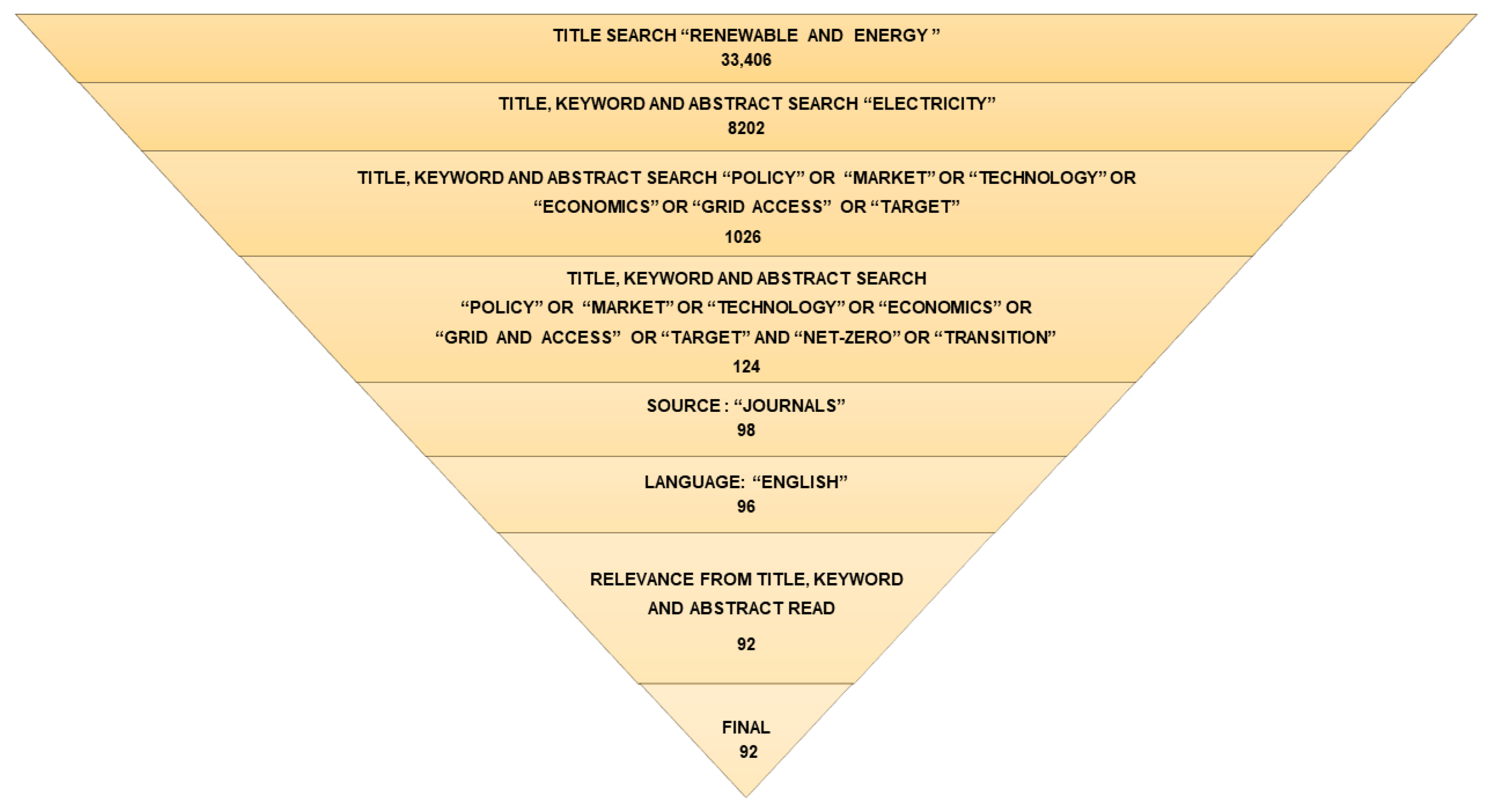
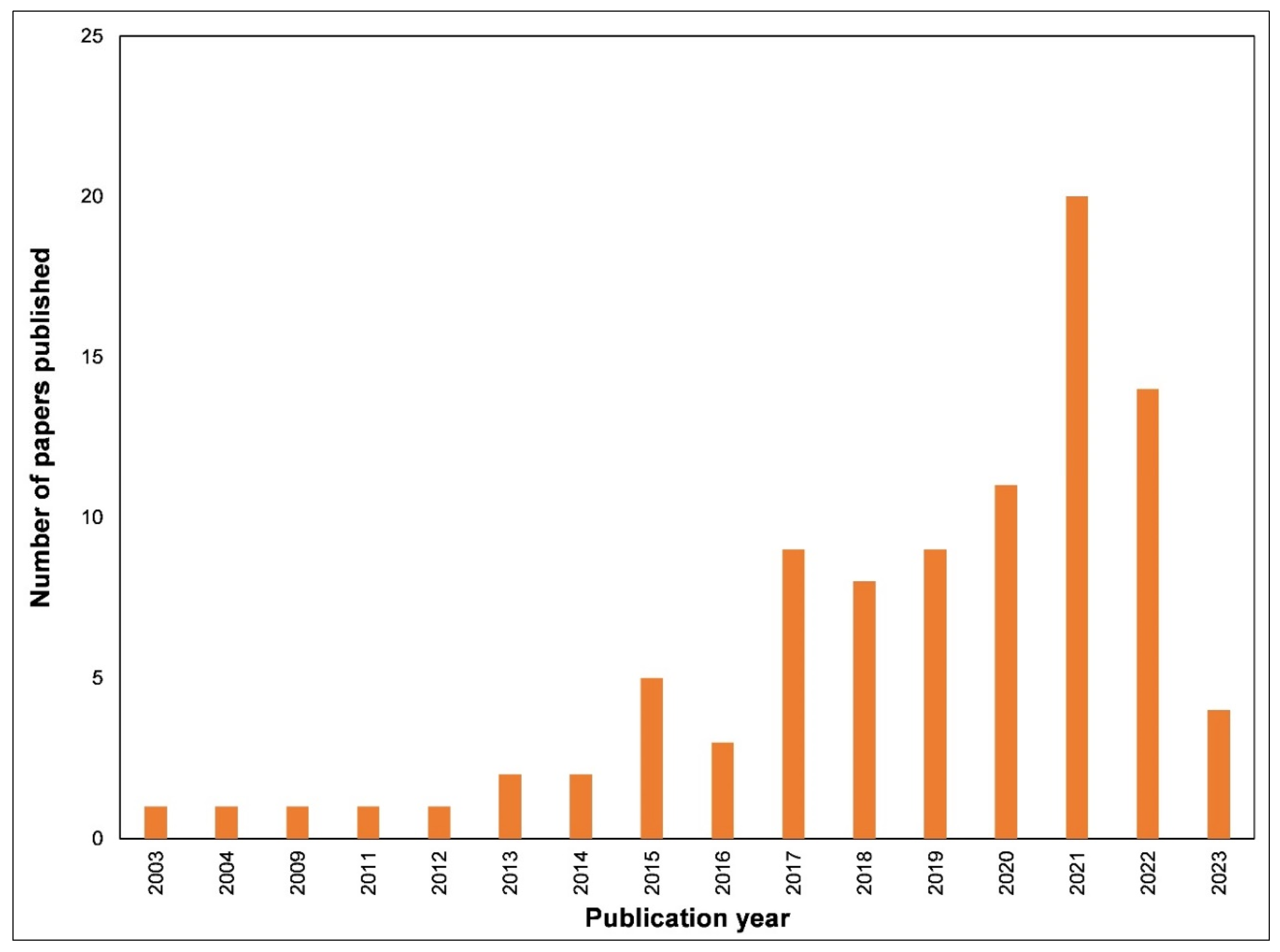
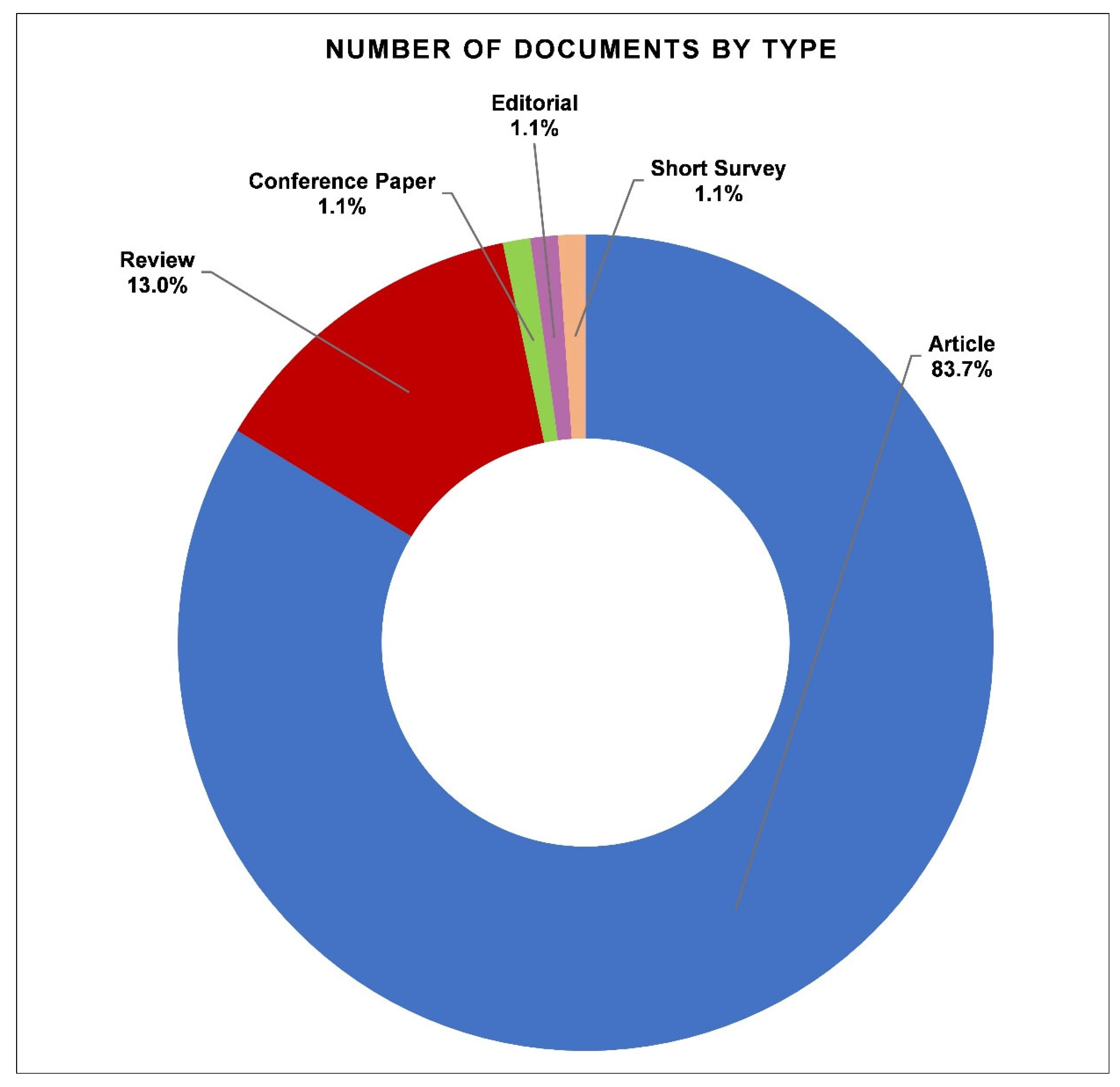
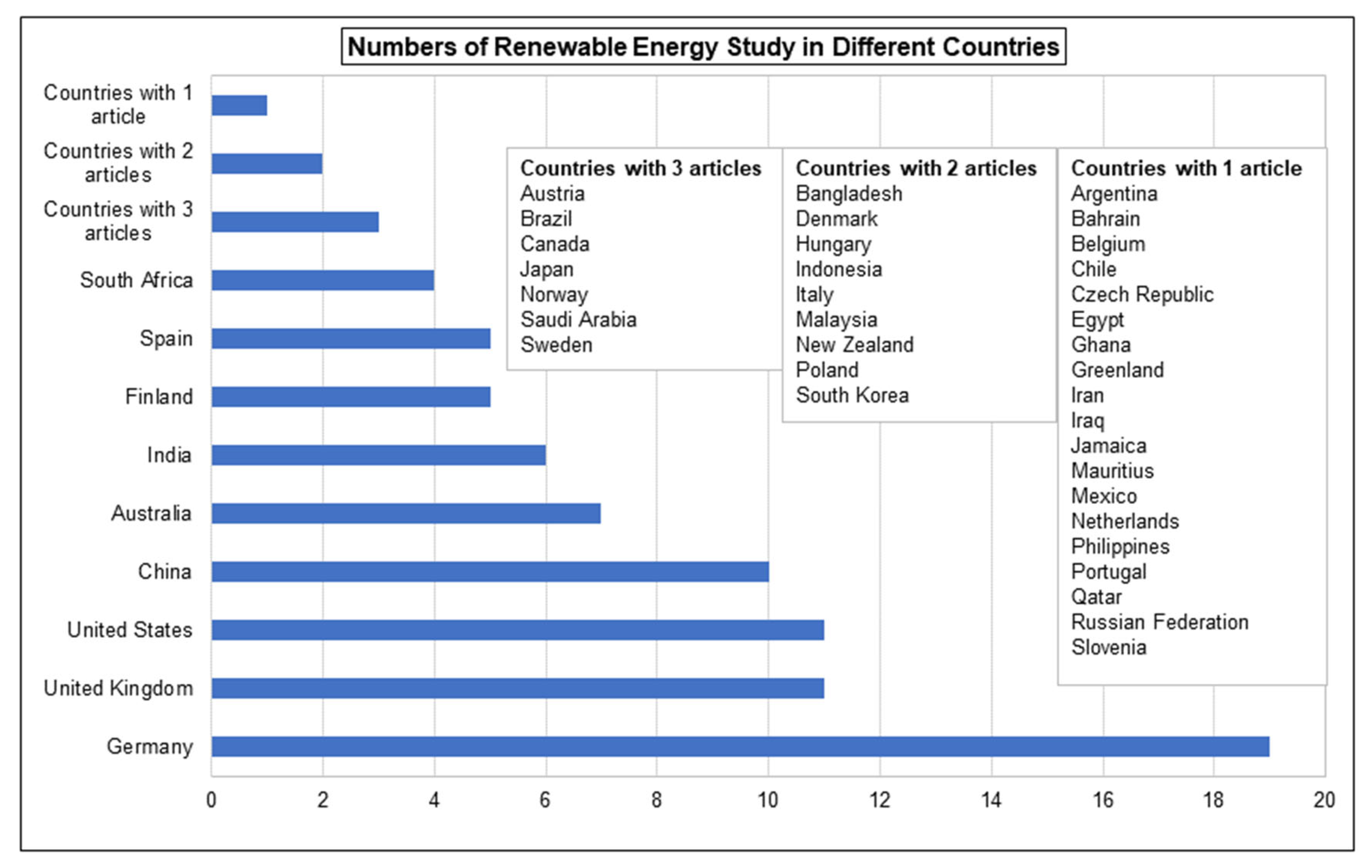
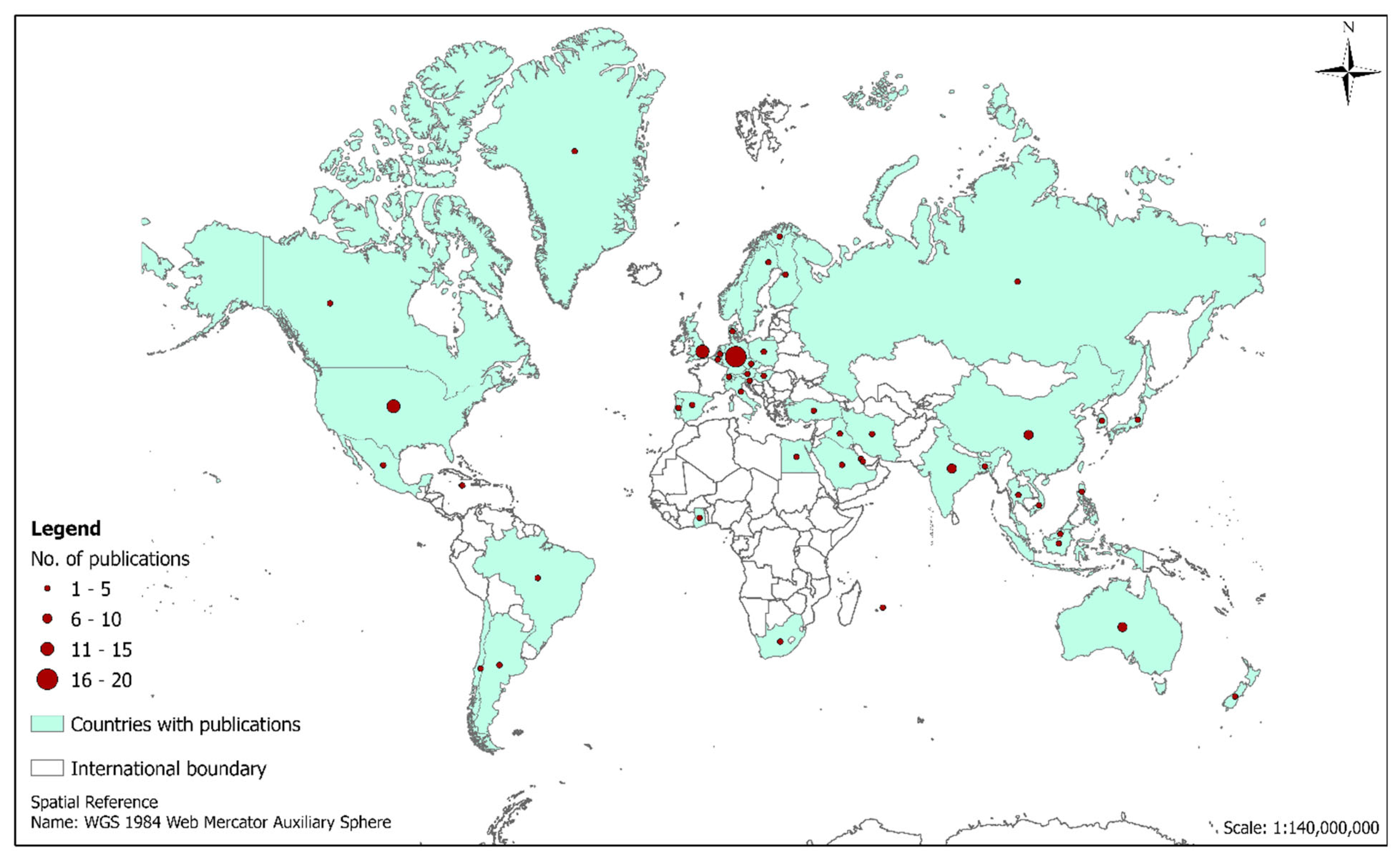

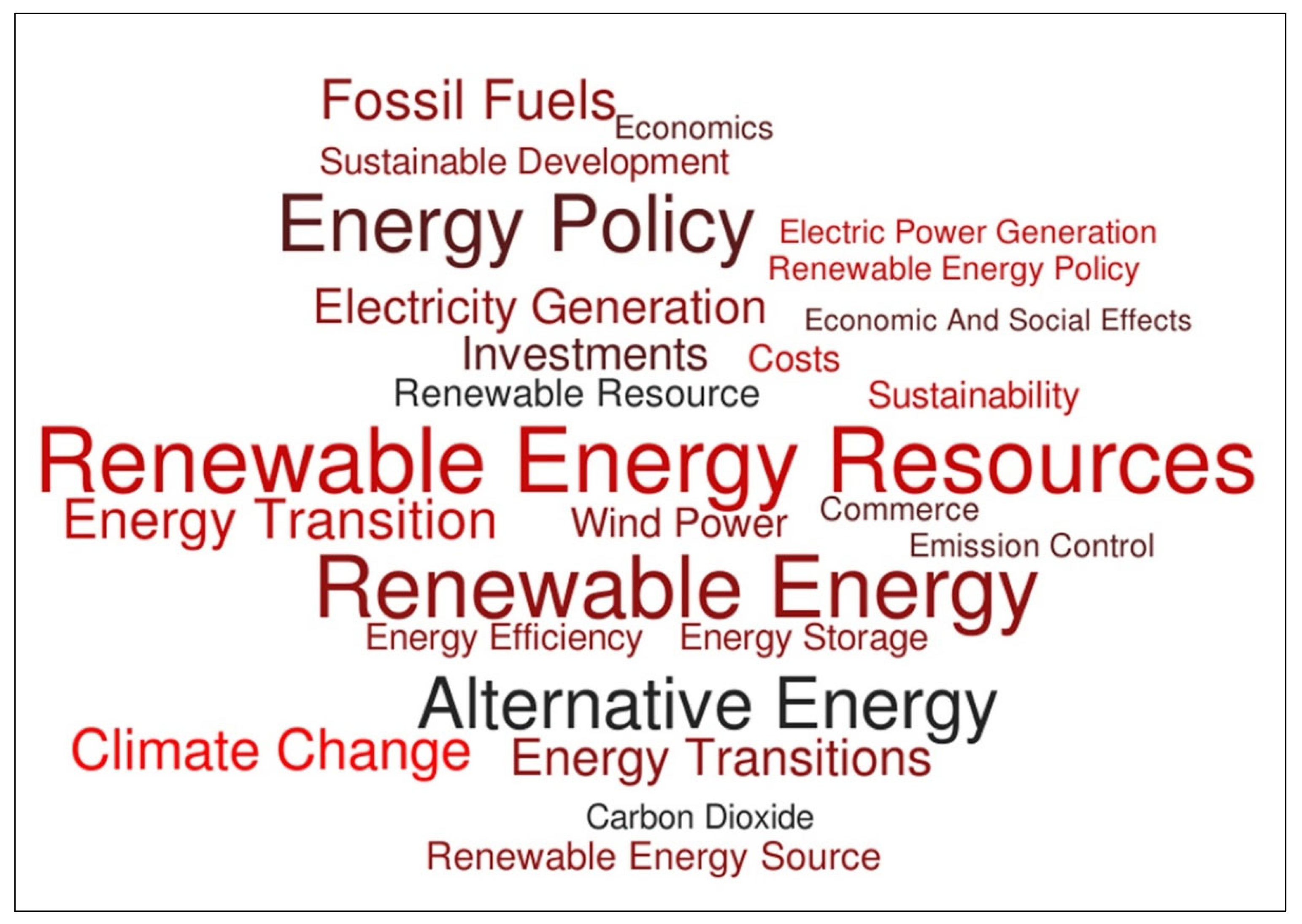
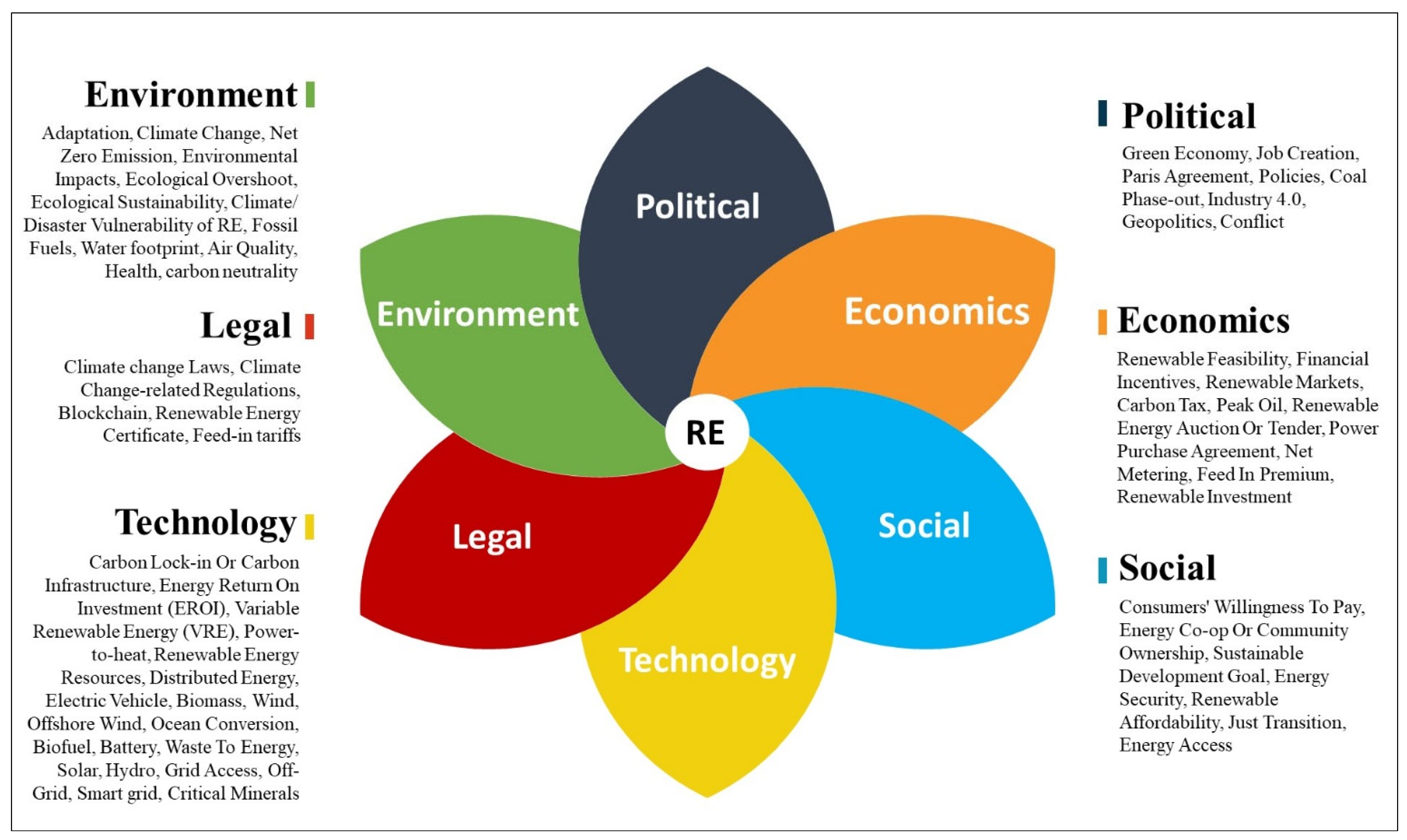
| Theme and Sub-Theme | Author and Date | % of Papers | Definition |
|---|---|---|---|
| 1. Political | |||
| Green economy | [27,28] | 10% | Public and private investment in environmentally-friendly economic activities, assets, and infrastructure to sustain abundant natural resources and the human population. |
| Job creation | [11,29,30] | 3% | New opportunities for paid employment in the renewable sector. |
| Paris Agreement | [31,32,33] | 20% | The Paris Agreement is an international treaty adopted in 2015 that covers climate change mitigation, adaptation, and finance. |
| Policies | [31,34,35] | 98% | A high-level overall plan embracing the general goals and acceptable procedures of a governmental body or company on climate change. |
| Fossil fuels | [36,37,38] | 42% | Energy formed in the Earth’s crust from decayed organic material. The common fossil fuels are petroleum, coal, and natural gas which release greenhouse gases. |
| Coal | [32,39,40] | 24% | Burning coal provides most of the electricity in the world by heating water to produce high-pressure steam that turns a turbine. |
| Coal Phase-out | [41,42,43] | 4% | Ending electricity generation and other energy uses of coal is a Paris Agreement target to keep global warming below 1.5 °C. |
| Industry 4.0 | [44,45] | 2% | Facilities and equipment involved in producing, processing, or assembling goods. |
| Geopolitics | [30,44,46] | 4% | The effects of the Earth’s geography (human and physical) on politics and international relations. |
| Conflict | [31,47,48] | 8% | Energy needs, drives, wishes, or demands that are in opposition or are not compatible causing a state of unrest. |
| 2. Economics | |||
| Renewable Feasibility | [49,50,51] | 27% | Overall viability for renewable energy applications or programs, considering economics, social technology, equipment, and staffing. |
| Financial incentives | [9,52,53] | 13% | Government support either directly or indirectly, including funding programs, grants, and loans. |
| Renewable Markets | [54,55,56] | 71% | Trading commercially to a target market to meet the needs of the customer for profitability. Energy is commercially traded through a transmission and distribution network to a consumer. |
| Carbon tax | [28,31,57] | 7% | A carbon tax is a fee the government imposes on fossil fuels. |
| Peak oil | [58,59,60] | 4% | Timeline after global oil production hits its maximum rate and begins to decline due to finite quality and quantity until it is no longer economically viable to produce. |
| Auction or tender for renewables | [28,38,61] | 4% | Approach to source renewable energy through competitive bids, selected for the lowest price. |
| Power purchase agreement | [49,56] | 2% | Energy contracts are between those who generate and those who will purchase the generated electricity. |
| Net metering | [28,56] | 2% | Energy credits are generated on their electricity bills for the excess electricity generated. |
| Feed in Premium | [28] | 1% | Agreements for renewable energy generation payments based on the wholesale electricity price. |
| Renewable energy investment | [27,57,62] | 54% | Financial resource allocation into projects, technologies and companies for renewable power generation. |
| 3. Social | |||
| Consumers’ willingness to pay | [52,63,64] | 4% | Willingness to pay for renewables is a measure of social acceptance for the maximum price that a consumer will pay. |
| Energy Co-op or community ownership | [30,39,65] | 3% | Regulations, legislation, and policies that guarantee or encourage full ownership or shared ownership of renewable energy projects for a community. |
| Sustainable development goal | [34,59,66] | 27% | The United Nation’s 17 global goals are to end poverty, protect the planet, and ensure that by 2030 all people enjoy peace and prosperity, including “take urgent action to combat climate change and its impact”, |
| Energy security | [42,45,67] | 43% | Sufficiency of energy resources to meet national energy demand at competitive and stable prices and the resilience of the energy supply. |
| Renewable Affordability | [65,68] | 2% | The extent to which renewables are affordable, relative to the amount the purchaser is able to pay. |
| Just Transition | [30,44] | 2% | A human-centered approach to address climate change, safeguard the rights of the most vulnerable people, and equitably share the burdens and benefits of climate change. |
| Energy Access | [28,33,44] | 37% | A regulatory mandate to provide access to a utility’s transmission and distribution facilities to move bulk power on a nondiscriminatory basis for a cost-based fee. |
| 4. Technology | |||
| Carbon lock-in | [47,67,69] | 36% | Carbon-intensive infrastructure locks in fossil fuel-dependent development. |
| Energy return on investment (EROI) | [70,71] | 2% | The usable energy extracted from a particular energy source compared to the energy required to extract, process, and distribute that energy source. |
| Variable renewable energy (VRE) | [13,72,73] | 27% | Dispatchable energy fluctuates and is intermittent in nature, such as wind and solar power, rather than controllable, such as dammed hydroelectricity. |
| Power-to-heat | [37,43,48,74] | 36% | Conversion of electrical energy into heat. |
| Renewable Energy Resources | [75,76,77] | 95% | Renewable energy naturally replenishes or is virtually inexhaustible but limited by energy available per unit of time. |
| Distributed energy | [49,72,78] | 25% | Interconnected individual and aggregated small-scale power generation resources into the electric grid, typically close to load centers. |
| Electric vehicle | [11,12,74] | 24% | A vehicle powered mostly or fully by electricity. |
| Biomass | [7,47,58] | 37% | Organic nonfossil material of biological origin constitutes a renewable energy source. |
| Wind energy | [23,49,55] | 78% | Kinetic wind energy convertable to mechanical energy for driving pumps, mills, and electric power generators. |
| Offshore wind power | [23,79,80] | 14% | Wind generated in bodies of water, usually at sea due to higher wind speeds offshore than on land. |
| Ocean Conversion | [79,81,82] | 4% | Process or technology of harnessing the temperature differences (thermal gradients) to produce energy. |
| Biofuel | [11,34,81] | 16% | Biomass feedstocks used primarily for transportation. |
| Battery | [36,45,48] | 23% | A battery is a device that stores chemical energy for electricity. |
| Waste to Energy | [9,58,79] | 7% | Municipal solid waste, landfill gas, methane, and other materials used as fuel. |
| Solar energy | [51,79] | 71% | Conversion of radiant energy of the sun into heat or electricity. |
| Hydro-electricity | [49,83] | 27% | Harnessing power of water in motion to generate electricity. |
| Grid access | [36,40,84] | 26% | All instruments, including laws and regulations that control energy connection, transmission, and distribution to electrical grid. |
| Off-grid | [50,65,85] | 13% | Generation of energy from independent renewables, such as solar and battery storage systems. |
| Smart grid | [72,75,86] | 11% | Advanced technologies to monitor and manage the electricity network from all generation sources to meet various end-users demand. |
| Critical minerals | [30,39,87] | 3% | Essential minerals for producing photovoltaic cells, electric vehicles, batteries, wind turbines, and electrical grid connectivity include cobalt, copper, lithium, nickel, and rare earth elements (REEs). |
| 5. Legal | |||
| Climate change Laws | [9,29,88] | 29% | Rules enforceable by social or governmental institutions to direct behaviors at all levels to mitigate and adapt to global warming. |
| Climate Change- Regulations | [10,29,54] | 22% | Governmen rulemaking anuthority in order to control an organization or system to mitigate and adapt to global warming |
| Blockchain | [56] | 1% | Blockchain is a distributed database or ledger to verify renewable power generation updated by multiple nodes, or participants, on a public or private computer network. |
| Renewable Energy Certificate | [24,76,89] | 10% | A permit for public convenience and necessity issued by a utility commission to provide some renewable services. |
| Feed in tariffs | [36,40,49] | 23% | Fixed payment agreements for renewable energy generation over an established period. |
| 6. Environment | |||
| Adaptation | [46,55,82] | 12% | Adjustment to actual or expected climate in order to moderate harm or exploit beneficial opportunities in humans or ecosystems. |
| Climate change | [27,42,54,61] | 82% | A shift in long-term weather in the mean and/or the variability over decades or longer. |
| Net Zero emission | [32,43,56] | 16% | Achieving an overall balance between greenhouse gas emissions produced and those taken out of the atmosphere. |
| Environmental impacts | [59,90,91,92] | 62% | Any environmental change, whether adverse or beneficial, resulting from a facility’s activities, products, or services. |
| Ecological Overshoot | [93] | 1% | Human demands on a natural ecosystem or the globe exceed its regenerative capacity. |
| Sustainability | [78,93,94] | 15% | The ability of natural and human systems to endure equitably. |
| Climate/Disaster Vulnerability | [61,83,91] | 3% | Risk of being adversely affected by climate change for humans or ecosystems. |
| Fossil fuels | [36,37,38] | 42% | An energy source, including petroleum, coal and natural gas, formed in the Earth’s crust from decayed organic material. |
| Water footprint | [60,90] | 2% | Volume of fresh water used to produce or supply the goods or services |
| Air quality | [52,59,92] | 5% | How clean or polluted the air is, which is associated with health effects. |
| Health Impacts of Energy | [33,54,62] | 23% | Climate change increases the risk of illness, as does working or living near industrial, mining, and waste sites for critical metals and fossil fuels. |
| Carbon neutrality | [32,80,95] | 8% | Balancing carbon emissions and absorption from the atmosphere in carbon sinks. |
Disclaimer/Publisher’s Note: The statements, opinions and data contained in all publications are solely those of the individual author(s) and contributor(s) and not of MDPI and/or the editor(s). MDPI and/or the editor(s) disclaim responsibility for any injury to people or property resulting from any ideas, methods, instructions or products referred to in the content. |
© 2023 by the author. Licensee MDPI, Basel, Switzerland. This article is an open access article distributed under the terms and conditions of the Creative Commons Attribution (CC BY) license (https://creativecommons.org/licenses/by/4.0/).
Share and Cite
Thompson, S. Strategic Analysis of the Renewable Electricity Transition: Power to the World without Carbon Emissions? Energies 2023, 16, 6183. https://doi.org/10.3390/en16176183
Thompson S. Strategic Analysis of the Renewable Electricity Transition: Power to the World without Carbon Emissions? Energies. 2023; 16(17):6183. https://doi.org/10.3390/en16176183
Chicago/Turabian StyleThompson, Shirley. 2023. "Strategic Analysis of the Renewable Electricity Transition: Power to the World without Carbon Emissions?" Energies 16, no. 17: 6183. https://doi.org/10.3390/en16176183
APA StyleThompson, S. (2023). Strategic Analysis of the Renewable Electricity Transition: Power to the World without Carbon Emissions? Energies, 16(17), 6183. https://doi.org/10.3390/en16176183






